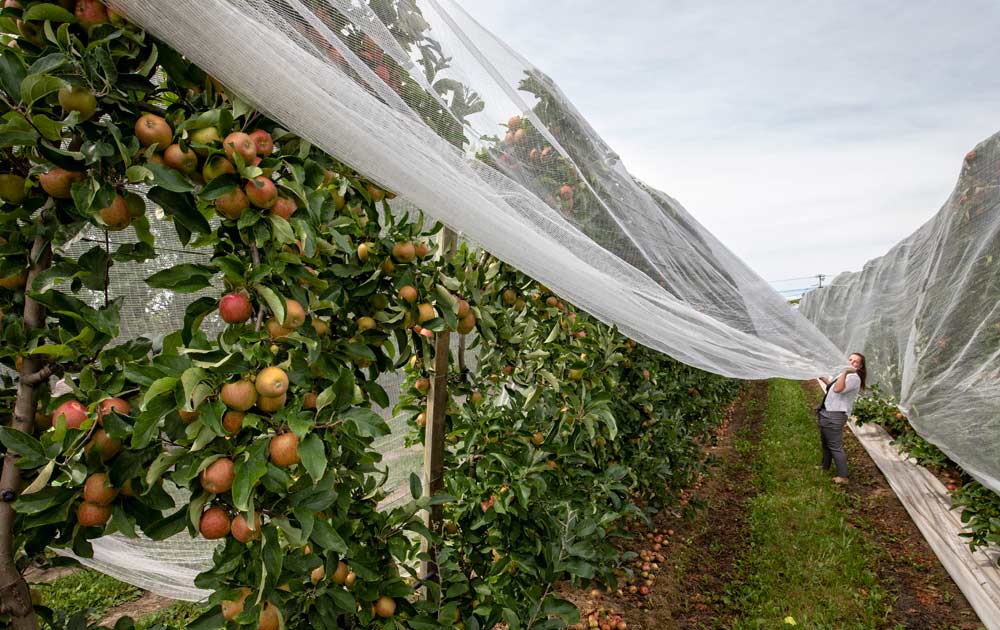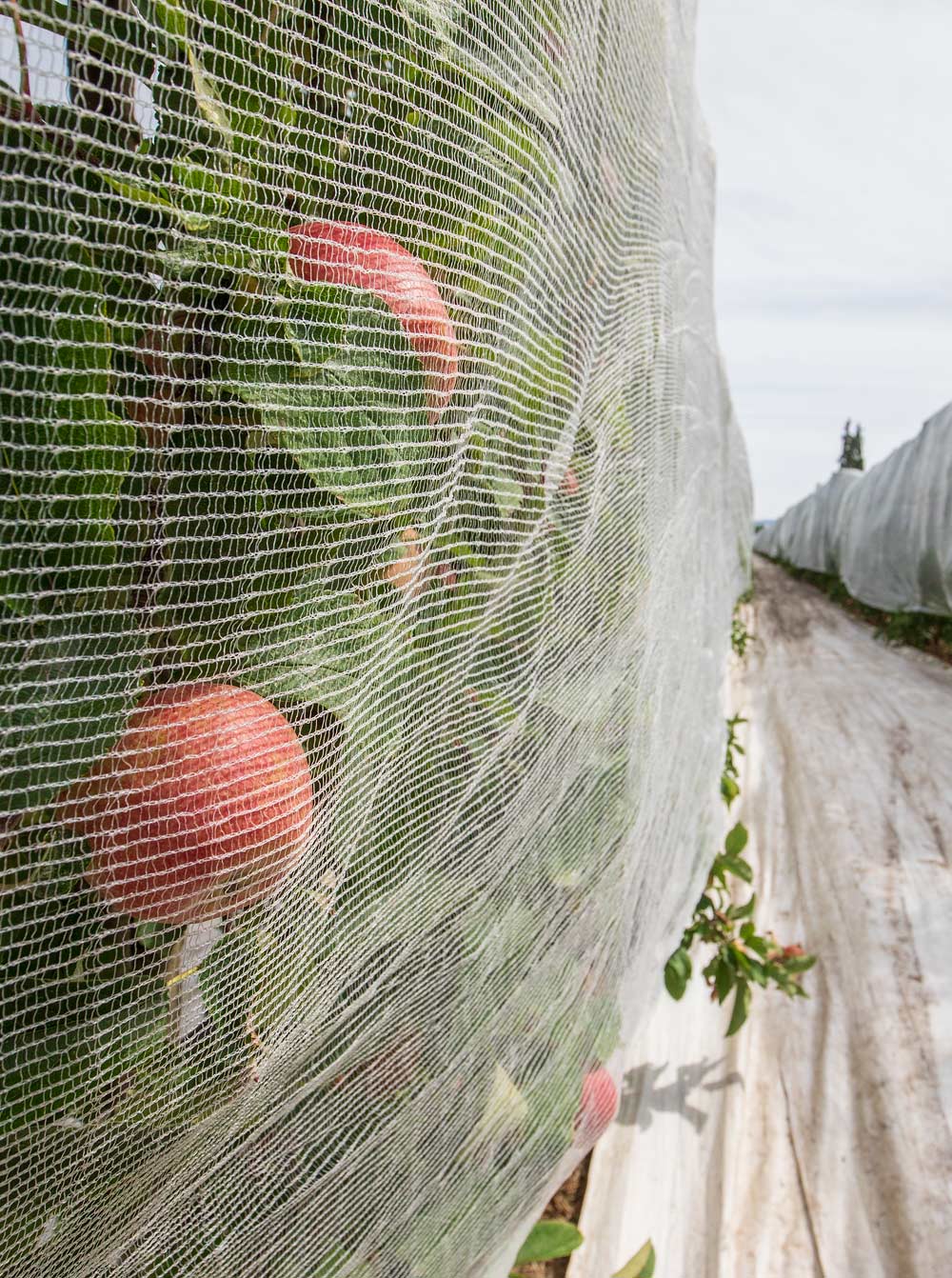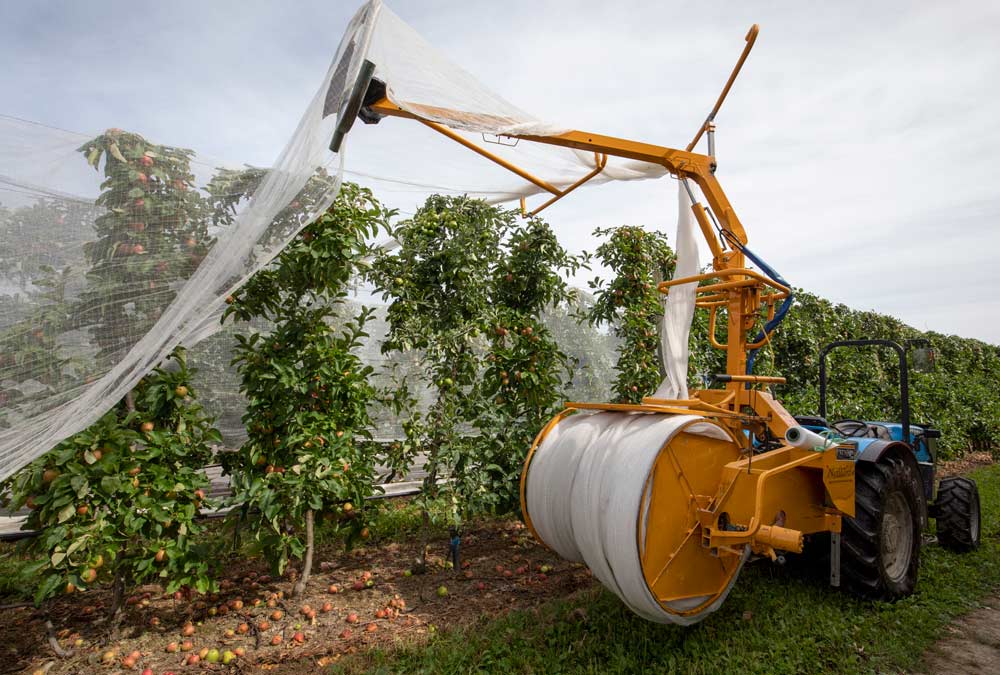
Drape Net staff member Ingrid Pilk pulls the over-row netting down from the top to fully cover this row of Envy apples during the 2018 International Fruit Tree Association New Zealand study tour in February in the Nelson area. Pilk was part of a two-person team demonstrating how fast she and the tractor driver (on opposite side of tree row) could install and remove the nets. Drape netting is getting a closer look in a broad study taking place in three different regions of the United States. (TJ Mullinax/Good Fruit Grower)
Universities in several states are examining the potential for drape netting to improve the quality of high-value apple varieties, in a cooperative effort intended to ultimately boost returns for growers.
In New York, researchers have installed netting for hail protection to optimize high-density apple production systems and improve the economic viability of small- and medium-sized operations and at the same time demonstrate the potential of the technology for those growers. Michigan State University researchers also aim to protect fruit from hail, while in Washington state the focus will be sunburn protection.
“We might not measure the same number of variables, but what we measure, we will share, and we will analyze the data together,” said Karen Lewis, who heads Washington State University’s tree fruit extension team. “The good news is that we’re evaluating these in three different climatic areas and covering a lot of different varieties because we’re doing it in three different states.”
The netting sites, ranging from 5 to 50 acres at four farms across the Western New York fruit region, are intended to protect Honeycrisp, Fuji, SweeTango and Evercrisp trees from hail, according to Cornell Cooperative Extension specialist Mario Miranda Sazo of the Lake Ontario Fruit Program.
Among the things to be evaluated by comparing netted trees to control trees without any hail netting system: tree growth, yield, harvest date, fruit color, fruit quality and return bloom in 2019. All are employing white nets.
Since the over-the-row system can reduce photosynthetically active radiation (PAR) by a minimum and 6 to 8 percent and ultraviolet light levels, improving the light environment at the lower part of the canopy will be potentially critical for fruit size, color and quality in an area with cloudy, low-light conditions like Western New York, Miranda Sazo said.
For that reason, the researchers also will use reflective material under tree rows to measure direct and reflected light at the lower part of the tree, as well as fruit size, yield, color and fruit quality, compared to blocks without reflective material.
Nets will be removed before harvest and stored at the end of each row during the winter months, he said.

Drape netting may better protect these Envy apples against pests and weather events such as hail. (TJ Mullinax/Good Fruit Grower)
In Michigan, researchers will evaluate netting for hail protection on four varieties: SweeTango, Gala, Honeycrisp and Granny Smith.
They’ll also be looking at fruit quality, shoot and tree growth and yields, as well as the microclimate — light and temperature conditions — inside the canopy, Michigan State University tree fruit educator Phil Schwallier said.
Schwallier said the researchers also will be examining the potential for netting to protect fruit from pests, including codling moth, oriental fruit moth, obliquebanded leafroller, plum curculio and apple maggot.
“The goal is that we hope to find out it’s well worth the money to pay for it, improves our quality, our productivity and our income,” he said.
The cost to MSU: about $3,000 per acre to install. Four growers are participating, with about 90 percent white netting. Two rolls of black netting will be used “just to mess around with,” Schwallier said, possibly on Granny Smith to try to reduce the red blush color and improve fresh sales.

A demonstration of a Net Wizz swivel mast installing Drape Net netting during the 2018 International Fruit Tree Association New Zealand Study Tour on February 19, 2018. (TJ Mullinax/Good Fruit Grower)
At Washington State University’s Roza Orchard in Prosser, Lewis said researchers will be evaluating both black and white netting on WA 38, the new variety to be sold under the name Cosmic Crisp, to evaluate the potential for sunburn control.
“I think that netting is a part of our future in some varieties, in some blocks and some locations,” Lewis said. “We need to evaluate different netting systems for their potential.” •
—by Shannon Dininny






Leave A Comment